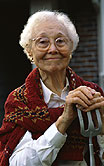
MONDAY, March 23, 2015 (HealthDay News) — Neither routine exercise nor vitamin D supplementation does anything to lower the overall risk for accidental falls among older women, a new Finnish study says.
However, the risk of serious injury as a result of falling was cut by more than half when elderly women engaged in regular exercise, according to the study.
“Falls are the leading cause of unintentional injuries and fractures in older adults — head injuries and fractures being the most severe consequences,” explained study lead author Kirsti Uusi-Rasi, a senior researcher and adjunct professor with the UKK Institute for Health Promotion Research in Tampere, Finland. “Therefore, falls prevention is important when trying to prevent injuries.”
Uusi-Rasi and her colleagues discuss their findings in the March 23 online issue of JAMA Internal Medicine.
Vitamin D is known to help preserve bone health, but Uusi-Rasi noted that prior research exploring the relationship between vitamin D supplements and/or strength and balance training and fall risk among seniors has been inconclusive.
To explore the protective potential of both exercise and vitamin D, investigators focused on just over 400 women between the ages of 70 and 80. The women lived at home in Finland during the study period between 2010 and 2013. None were deficient in vitamin D prior to the study.
Participants were divided into four groups: a vitamin D alone group; a vitamin D with exercise group; an exercise alone group; and a group that neither exercised nor took vitamin D.
Those taking vitamin D were given a daily dosage of 800 IUs. Those who exercised did so under the supervision of physical therapists in a class setting, twice a week for the first year and once-weekly classes during the second year. Classes focused on improving balance, strength, agility, movement, and the ability to lift weight.
The result: Over the course of two years the risk for falling was found to be more or less equal across all groups.
However, supervised physical training was associated with a dramatically lower risk for serious injury when falls did happen. Serious injury was defined as experiencing a fall that results in having to seek medical care for bruising, abrasions, contusions, sprains, fractures and/or head injuries.
The study suggests that “exercise seemed to be more effective in reducing injurious falls in this age group,” Uusi-Rasi said, “with or without vitamin D.”
By contrast, vitamin D supplements were not linked to a lower risk for serious injury, whether taken alone or in combination with exercise. Vitamin D supplements did help maintain, or even slightly increase bone density in certain areas, according to the study.
“Exercise improves functionality,” said Uusi-Rasi, who added that the women who exercised showed improvements not only in muscle strength and power, but also in mobility and balance. Such improvements, she theorized, might generally enable older women to fall in a safer way, though her team did not specifically explore that question.
Although the study didn’t include male participants, Uusi-Rasi said exercise is probably equally protective for men. She noted that earlier research has suggested that exercise has a similar beneficial impact across gender.
In an accompanying editorial, Dr. Erin LeBlanc, an investigator with the Kaiser Permanente Center for Health Research in Portland, Ore., cautioned that the conclusions about vitamin D may not apply to all seniors, given that the Finnish pool of subjects were all white females who started the study with optimal vitamin D levels.
“[It’s] surprising because previous studies have found that vitamin D can prevent falling,” LeBlanc said. “But the studies have all been slightly different, and these differences could explain the different findings.” On that score, she noted that it’s possible that the specific vitamin D dosage offered to the Finnish group was somewhat lower than ideal.
Regardless, LeBlanc argued that it’s too soon to rule out vitamin D as a fall preventative, given that it — and exercise — are both inexpensive and low-risk, and have previously been associated with fostering greater muscle strength and balance.
More information
There’s more on seniors and falling risk at the U.S. Centers for Disease Control and Prevention.
Copyright © 2025 HealthDay. All rights reserved.

